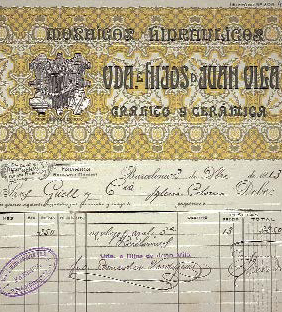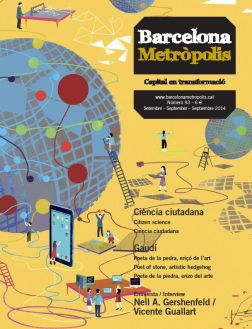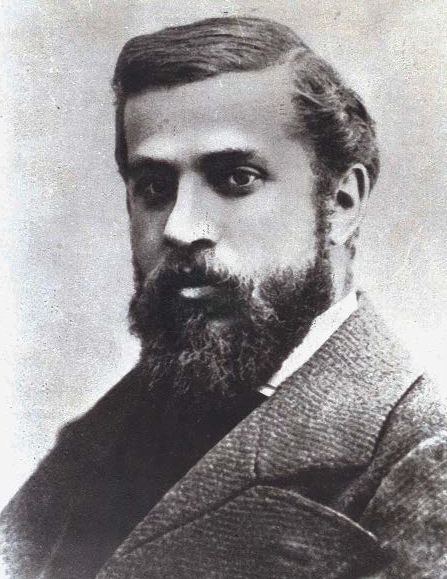New research has revealed a pioneering Gaudí who was well ahead of his time, the creator of innovative work processes, in addition to the architectural forms that we all now know. The architect has left us a legacy that can be applied to a range of disciplines.
The Diocesan Museum of Barcelona houses the book of condolence from the death of Gaudí. It is a considerable tome, documentary evidence of the architect’s renown and the resonance of his presence. In it we find the names of political and cultural personages along with countless unidentified individuals. Of these individuals, who represent the majority – proof of how Gaudí was loved by the people – one name in particular caught my attention.
It was nobody. What I mean is that this person was no authority, no one well known. Struck by the tragedy and aware of what the loss meant, this person expressed his grief and admiration on a sheet of paper. The text is beautifully written, measured in tone and rather long. The author must have given it careful consideration, because there are no second thoughts or erasures, and the text ends with a brilliant analogy: “If Verdaguer was the architect of literature, Gaudí was the poet of architecture.” Full of determination, the man must have gone to the chapel with his own paper, only to find that there was an official book of condolence. So he attached his text with pins, on the very page opposite the signatures of major figures in politics, art and society. The book is exhibited with this page open.
The magnitude and power of the collective grief expressed in writing is impressive. For the authors of the countless letters, telegrams and press articles, a saint, genius and patriot had died – the architect of God and the universe, the Dante of architecture. So clear, so resounding and so shared. But the fate of Gaudí quickly fell into a prolonged period of neglect and even contempt. Paradoxically, almost three-quarters of a century later, he would become one of the most original icons of Barcelona and in the history of art.
From the time of his death in 1926 until today, Gaudí has been the subject of much debate: a debate that has often been more ideological and political than artistic in nature, while the majority of the original avant-garde – as well as the second and third generation – have been overtly fascinated by him. That’s the way it was and has been from Walter Gropius and Le Corbusier to Miró and Perejaume, crossing over elective antipodes such as Tàpies and Dalí at the other end of the spectrum, who defended the “organic, terrifying and edible forms, sacred in essence”. A curious case: in 1927, Herman G. Scheffauer, a journalist from The New York Times Magazine, said that Barcelona was “the most fantastic city in the world” thanks to the innovative and creative nature of the new art in Catalonia, the leading exponent of which was Gaudí, creator of the Sagrada Família, “a stupendous building” representing “a harking back to the Gothic”, with “forms from the animal and vegetable worlds” and “smooth spires designed in corkscrew form” that “ape the long, slender, tapering lines of the Rhine wine bottle.”
More apparent paradoxes: despite the ups and downs, Gaudí’s works have always enjoyed popular appeal, which has considered the forms its own until the economic cannibalisation of tourism took them, in a process of a public expropriation for public use. A continuously accelerating process of reducing Gaudí to an economic asset, more related to “Gaudimania”, merchandising and tourism’s contribution to the GDP than to culture and civic use. L’Hospital de Sant Pau and Park Güell are recent examples, along with the loss of the expiatory and charitable meaning of the Sagrada Família. It is a topic worthy of debate.
This long journey of comings and goings, losses and claims, has included permanent islands dedicated to the salvation, research and preservation of Gaudí’s legacy, although always surrounded by storms of controversy:
— The continuity of the stone, work and desire of the Sagrada Família. Always resistant to attacks from numerous insults and smear campaigns, thanks to the moral authority bestowed on it by the importance maintained from the sources and their values (Ràfols, Matamala, Jujol, Martinell, Puig Boada, Bonet Garí, etc.).
— The few individuals such as Garrut and Bassegoda who, often from the sidelines, saved and studied pieces, works and documentation, and strove to preserve Gaudí’s interpretative stone words – very often in contact with the research and efforts of the international avant-garde (from Frei Otto to Collins) – while in Catalonia the topic lay dormant. Special mention should be given to the humble yet persistent work of the Amics de Gaudí [Friends of Gaudí].
— A series of intellectuals who, while not moving in the circles of Gaudí followers, recognised his value and fought against scandalous vacuity. This group includes the innovative, prophetic and spirited vision of Juan-Eduardo Cirlot.

© Pere Virgili
Gaudí checked all his invoices jointly with his supervisors and assistants, and signed them personally. This one is from a supplier of mosaic tiles and his signature can be seen on the bottom right-hand side.
— And, especially, an anonymous collective who have safeguarded both Gaudí’s memory and the material and documentary evidence that, upon being rediscovered, have revolutionised the understanding of the genius. I would like to make special mention of the people at Colònia Güell as well as Gaudí’s employees and collaborators, who Manuel Medarde has come to know, study and love. A master of the scientific research method, Medarde has managed to combine the direct study of Gaudí’s works – done in a multidisciplinary way without preconceptions – with the study of sources and documents, while also applying the anthropological fieldwork to those who knew and worked with the master. This research method has led him to recover hundreds of pieces and items, and most notably 5,800 unpublished documents written by Gaudí himself.
The results of this now erupting research are so alluring that we can (re)write an authentic and well-documented story about Gaudí, reaffirming some things, clarifying others and providing contradictions where necessary. Along with a return to original documentary sources (Ràfols, Matamala, Puig Boada, etc.), the new knowledge forces us to directly re-examine his works from fresh perspectives and position Gaudí in his rightful place from an academic perspective. The first step: publish. The second: display. The third: fill inexplicable gaps such as the lack of Gaudí academic chairs.
But there’s more. We’ve uncovered some aspects of Gaudí that came as a surprise. The research, in an unexpected twist, has become a seed and a driver for present innovation. We have discovered a Gaudí who was pioneering, well ahead of his time, creator of innovative work processes, in addition to the new architectural forms that we all now know. A creator-cum-inventor-cum-innovator who, beyond his identity as an architect, and based on his matchless style, brings us a legacy that can be applied to many disciplines today, from ergonomic design to business management.
… Gaudí is complex, very complex
Gaudí meandered between architecture and social action, wending his way through all areas and paths of art, science and management. Through chemistry, the 3D and high-resolution photography, lighting and chromatics for practical and symbolic purposes. Through the worlds of film, social cooperatives, education, feminism, Christianity and anarchism. Through the corporate and business worlds, where he broke ground by taking the first steps in co-working, co-design, networking and just-in-time production. Through health and safety at work. Through mastery of the craft and the incorporation of design. Through ceramics and woodwork.
Through inventions of whatever he needed and wanted and through the admiration for Edison as a model and guide. Through ecology as an idea and foundation, through energy efficiency as a desire and a necessity, and through naturalism, recycling and sustainability. Through something as modern as engineering as a necessary partner for architecture, through constructive physics, geometry, calculus and modelling before plans. Through gastronomy, health and sport in the functions of the architect’s practice. Through music and the acoustics of objects and spaces. Through liturgy and social use in architectural design. Through urban planning and landscaping. Through R&D&I as a work method…
Gaudí is all of this; he concerned himself with every detail, studying and working with ad hoc teams, in a masterful combination of fixed and flexible teams that were always interdisciplinary. He applied everything that was appropriate or necessary to his work, and if it didn’t exist he invented it, whether it was an object, material, technique or method. With Gaudí, everything is united and makes sense: there’s no room for improvisation or futility. Work and thought, human and technical functionality are the warps and wefts that, if taken away, leave you without a garment and with a fistful of senseless threads.
It’s like a puzzle: the pieces are seemingly incomprehensible and isolated, and it seems like some are surplus. The key that gives us the overall, clear and defined picture is the method that Gaudí created. Therein lies the inventive genius of the master and the only way to understand his style, which during his time was said to be so strange and original that it was incomprehensible. Etsuro Sotoo told me years ago that “Gaudí’s contribution was so immense that it could not be understood during his time. Maybe in the twenty-first century…”





Gràcies Marià,
M’has fet entendre una mica més aquest gran home de ha fet més gran el nostre país.